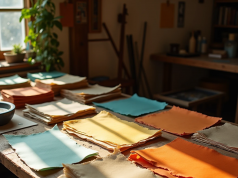Paper is made from ground wood. Any schoolchild knows this. Perhaps, this is the end of our knowledge about one of the most popular materials for household and industrial use. The article in the encyclopedia will expand our knowledge a bit.
Having appeared in ancient China, paper had to make a long and thorny way to Europe - the secret of its production became known to Europeans only in the XI century. Since those times and up to the middle of the XIX century all over the world paper products were made according to the ancient Chinese technology, although of course somewhat modernized. The raw materials for production, as in ancient times, were rags and various fibrous materials of plant origin: bark, plant parts.
European manufacturing, including book printing, was developing rapidly. In addition, in the 19th century, the first paper machine was invented, which could process large quantities of raw materials. It was simply impossible to collect so much rags to "feed" it. And what is there a lot of on Earth? Forests! So paper changed its origin and from "rags" became "wood".
A few words about the structure of the material
Sometimes knowledge of theory can be very useful in practice. For example, why is a sheet more tear-resistant in one direction than in another? In answering this question, we must remember that the material is made of fibers. When the fibers of the wood pulp are placed on the moving screen of a papermaking machine, they gradually take the direction of its movement.
The fact that paper has a fibrous structure can be understood by performing a simple experiment. Take a sheet of paper and tear it first lengthwise and then crosswise. It can be observed that in one direction it tears unevenly and with effort, and in the other direction it tears more evenly and easily. The torn edge of the sheet means that in this part of it the fibers lie across, and more even - along. When making paper crafts, this knowledge is useful.
So, after the experiment is over, we are left with a handful of torn paper in our hands. It used to be a green tree branch. Then it was a notebook or a newspaper. In its final role, it was the material for the experiment. Now another adventure awaits it - the scraps are to become a whole sheet of paper again. And using almost the same technology followed by the ancient Chinese in the production of paper.
Stages of making paper with your own hands
To make 3-4 notebook-sized sheets, you will need a small pile of waste paper. For example, 4-5 scribbled notebook sheets and 2-3 newspapers.
1. Tear the prepared paper into shreds of two or three centimeters in height and length, putting them in a bowl. Pour a little water in it and leave it to soak for 3-4 hours.
2. Stir the mixture well with your hands, making its fractions finer. If you use a mixer or blender, the mixture will be more plastic. After mixing the mass in it you can add a little PVA glue, then the resulting paper will be stronger, and it can be used for crafts. However, in this case it will be more correctly called papier-mache.
3. Dilute the thick paper pulp with water quite liquid. Pour it into a small wide container: a basin with a flat bottom, a cat litter tray, a washing machine lid (just the last variant is used in the photo).
4. We take a flat frame net and scoop up the mass with it. We don't have, of course, the handy bamboo nets used by Chinese craftsmen. But as a tool for scooping out the raw material, any one will do. You can also use a tennis racket, sewing a layer of gauze to one of its sides. When scooping the paper pulp from the basin, shake the net slightly so that the mass is evenly and finely distributed on the surface.
5. Let the water run off and blot the drops from the bottom with a sponge. Then cover the layer of wet mass with a piece of cloth and turn the net over. Carefully lifting it from one side, we leave the composition on the cloth. We put the blank of the future leaf on the newspapers. Cover with another piece of cloth, newspapers and put a press (books, a board with a stone, some other heavy object) on top.
6. After an hour, carefully take out the dehydrated and leveled homemade paper sheet and air-dry it, or use a hot iron through a cloth.
The texture of homemade paper is quite interesting. At a glance, the material resembles wallpaper, and to the touch - thin cardboard. Such paper has excellent decorative qualities, which can be increased many times over, if at the stage of laying under the press, lay out on the raw surface of the paper mass with leaves, flowers, rhinestones (fantasy is welcome!) drawing or ornament. After drying, it will become part of the sheet structure.
Homemade paper can be made smoother and more elastic. For this purpose, a stone or any heavy smooth object is taken and used to smooth the sheet placed on a hard flat surface.
Homemade paper has some unexpected charisma! It is pleasant and even joyful to hold it in your hands. However, perhaps, like any other useful and beautiful thing made with your own hands.







